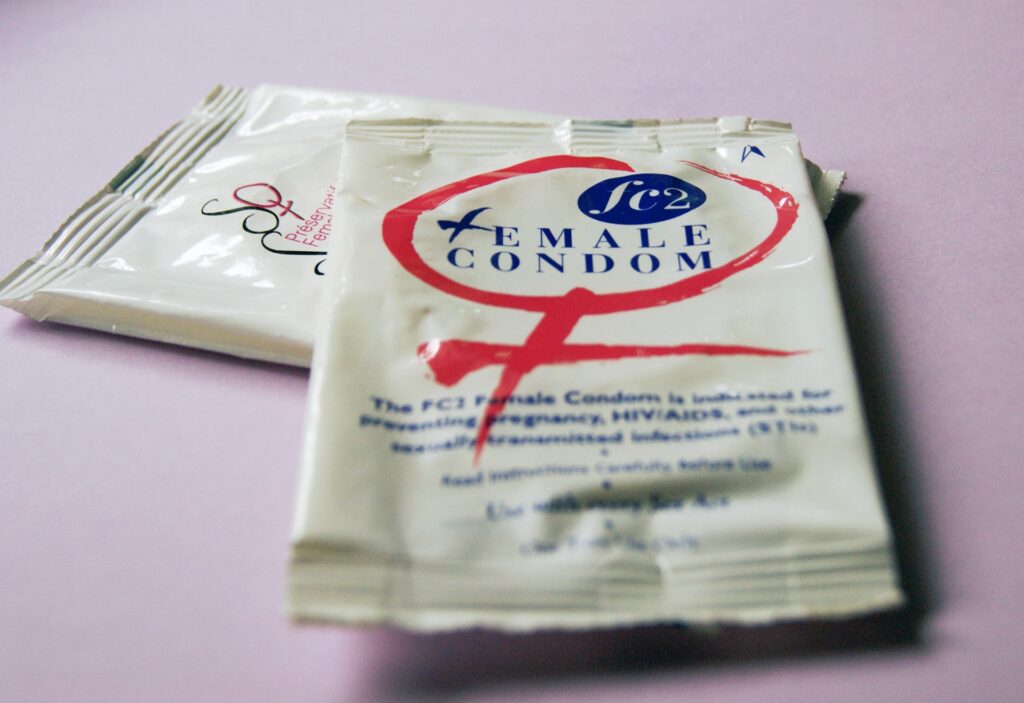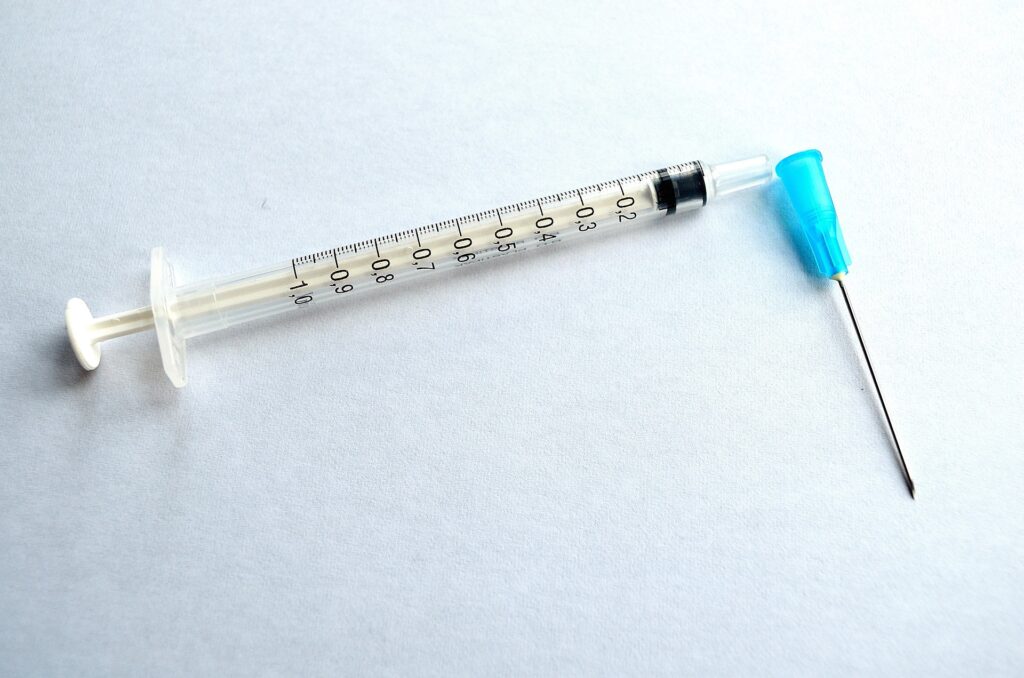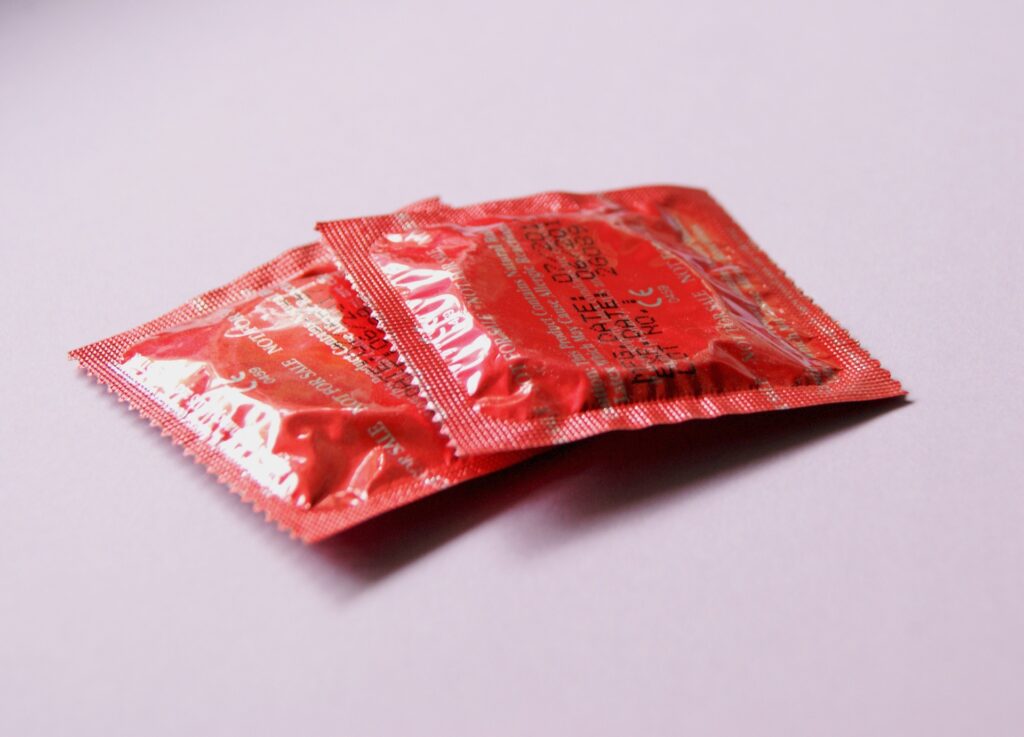You might want to start a birth control method to reduce period unpredictability, cramps or prevent pregnancy. Irrespective of your health goal, it is necessary to choose the safest birth control method that we discuss here. Before you go through them, you should have answers to move ahead with a clear objective:
- Do I want to regularize my periods?
- Should I choose natural contraceptive methods?
- Do I want to use birth control that I can quit immediately, or do I commit for the long term?
- How soon do I plan to get pregnant?
Your answer will determine the best birth control method suited for you. This blog will help you make the correct decision. However, it is best discussed with a gynaecologist to ensure you move on the right track.
Birth control method without prescription
There are non-hormonal birth control methods that you can source without a prescription. These include:
1. Condoms
Condoms cover male genitals to prevent their fluids from entering a female’s body during intercourse. Most products promise 97% chances towards pregnancy prevention if used correctly.
Experts promote the usage of condoms when couples are not planning for pregnancy. As condoms prevent the chances of sexually transmitted diseases (STDs), using it is a healthy sexual practice. STDs are more common in women than in men due to larger mucosal surface area.
STDs can be curable or incurable. While syphilis, gonorrhoea, trichomoniasis, and chlamydia are curable diseases, HIV, HSV, HPV, and hepatitis B are not.
You might be unaware, but females can also wear internal condoms meant for vaginal usage. Male external condoms are more prevalent as they cover externally and are easier to use.

2. Spermicide
As the name suggests, spermicides are products that kill sperm so that they do not enter the female body. There are types of spermicides sold in the form of cream, foam, and suppositories. People who frequently use spermicides like it as it works like a lubricant. However, it does not protect against STDs.
Spermicides are not popular due to their low efficacy rate among other birth control methods. Many use it alongside condoms for better protection. You can also use a cervical cap and diaphragm to safeguard it further.
3. A contraceptive sponge
Contraceptive sponges are products filled with spermicides and placed inside female genitals before intercourse. The sponge works like a protective layer against the cervix and blocks male sperm from entering.
Most women dislike such birth control methods as they must rest inside their vagina six hours after a sexual encounter. Females who do not use tampons and menstrual cups might not want a sponge entering the vagina as well. While the sponge absorbs the sperm, it does not protect against STDs.
4. Ovulation kit
An ovulation kit helps women track their ovulation period to keep them alert about their sexual activities. If you avoid sexual intimacy during the time you have a chance of pregnancy, you can prevent fertilisation.
Ovulation kits might not be accurate. If you have regular periods, you can track your ovulation period by keeping track of dates. Using a menstrual-tracking app on your smartphone will make this easy.
Birth control method with prescription
You cannot procure several birth control methods for females without a prescription. These can be both hormonal or non-hormonal.
Let us go through them in detail and find the safest birth control method for you:
Birth control methods that are hormonal
Birth control methods can disrupt your hormones fall under this category. For example, a birth control implant is hormonal as it uses an intrauterine device. It also requires you to take injections and medicines. The method involves artificially implanted progestin and oestrogen.
Hormonal birth control types inhibit the process of ovulation. It either refrains the possibility of fertilisation or thickens cervical mucus to prevent sperm from entering.
5. Birth control pills
Depending on your geographic location, you might or might not need a prescription to purchase birth control pills. There are different types of birth control pills:
- Oestrogen-free progestin-only pill (POP)
- Combined hormone oral contraceptive pill (COC)
- COC pill for extended-use
The birth control pill that best suits you will differ if you:
- are a lactating mother
- accept bleeding withdrawal
You must involve an expert before starting a course. You might have to consume this every day. It is unhealthy for most and can have detrimental side effects.

6. Patch and ring
If you do not want to consume pills daily, insert a ring and use a patch. Patches are plastic bandages you need to stick to your body while inserting the ring through your vagina.
Your skin absorbs hormones from the patch and requires weekly replacements for three weeks. You need to remove it in the fourth week, and you might face bleeding as a withdrawal. The ring stays inside your vagina for three weeks and is then removed. This, too, will cause bleeding withdrawal.
7. Injection
Taking an injectable progestin can also prevent pregnancy. Each shot lasts three months. So, you need to take four doses per year to continue this birth control contraceptive.
Shots are one of the preferred birth control methods, as these are convenient. However, it is hormonal and can disrupt bleeding patterns for the first few months. There can be excessive bleeding or no bleeding during different menstrual cycles.
When you stop taking the shot, you will not become fertile overnight. It is best to stop it for 12 to 18 months before you start planning for pregnancy.

8. Birth control implant
Birth control implants are the most prevalent hormonal remedy due to their high efficacy rate. It only includes progestin. Birth control implants come in the form of a sleek rod. Doctors insert it under the skin on your upper arm.
Depending on your doctor’s recommendation, you can keep it as is for 1 to 3 years. You need to revisit the clinic for assistance with removal or replacement. Birth control implants can cause pain, swelling, and bruises.
9. Intrauterine device (IUD)
IUD is a birth control product that women can insert inside their uterus. The tiny product looks like a T shape and effectively prevents pregnancy.
IUDs are hormonal and differ from one dose to another. These products can work for 3 to 8 years. You can only insert this with clinical assistance, and you may feel cramps as a side effect.
Irregular bleeding is also common when using IUD, as it takes a few months to adjust to your hormones. After about 3 to 4 months, your menses will regularise. However, if you have less or no bleeding, this product is unsuitable for you.
Birth control methods that are non-hormonal
Non-hormonal birth control methods do not disrupt your hormonal levels. However, you cannot acquire them or try them without clinical assistance.
10. Copper IUD
The copper IUD looks like a regular IUD but is not hormonal. These products use copper wires to generate ions that help create an inhospitable environment for sperm.
Although the inflammatory response works towards pregnancy protection, it increases menstrual cramps. You might experience heavier bleeding. These are reasons why women prefer hormonal IUDs compared to this one.
11. Diaphragm and cervical cap
Both diaphragms and cervical caps are products that cover your cervix to block sperm. Diaphragm and spermicides are used together and must stay there for at least six hours after intercourse.
Diaphragms have different sizes depending on the fit that works best for you. So, you need a healthcare expert to supervise this for you.
Once the perfect product is placed inside your cervix, you must undergo pelvic tests to confirm efficacy.
Cervical caps are smaller in size but perfectly fit the cervix. However, these birth control methods do not protect you from STDs.
12. Phexxi gel
Phexxi is a relatively new concept, but doctors prescribe this for pregnancy prevention. You need to use this gel on your vagina to lower pH levels. Due to this phenomenon, sperm cannot pass through the uterus. However, this is not 100% protective against sperm meeting the egg.
Women need to apply this gel to their vaginas before intercourse. It is an immediate birth control technique and works for one hour from application time. It is best to use Phexxi along with other contraceptives like condoms. Do not use Phexxi with patch and ring.

13. Sterilisation
Sterilisation is the ultimate birth control solution for people who never want to have children. Sterilisation can be done either by a female or a male.
If you are a woman who does not wish to conceive, you can go through tubal occlusion. Whereas men have a vasectomy.
These are outpatient procedures that have a quick recovery rate. Sterilisation relieves you from the fear of pregnancy once and for all. However, you will never be fertile again.
Final Thoughts
The best contraceptives are non-intrusive and non-hormonal. These do not disrupt your menstrual cycle and free you from the worries of conception.
While condoms are the most safest option, women have to depend on men to protect them against pregnancy. As a female, if you want to take charge of your birth control, you have to pick one among the hormonal or non-hormonal options. You must consult a gynae for expert advice and supervision over your case.

